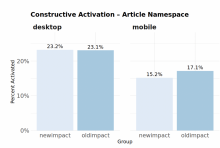User story:
As a Product Manager, I want to explore the difference in activation rates between the new and old Impact module's empty state on mobile, because I want to be sure all Growth features improve activation and retention.
Background & research:
Impact module leading indicators seem healthy and we've received positive feedback about the new design from newcomers and experienced editors. However when we look at Activation data we see that is appears there is a slightly lower activation rate for the new impact module on mobile:
Before a newcomer has activated (edited for a first time) they will only see the impact module's empty state. So this change in activation only relates to the empty state, not the actual new impact module. The old empty state design is very similar to the new empty state design, so we would expect to see no change in the Activation rate.
| Old Impact module | New Impact Module |
Questions:
- We've released some improvements to the Impact module empty state logic and loading (example: T324285 & T322832), is it possible that some of those edge cases were enough to cause this discrepancy? Are there other edge cases we aren't considering?
- Is there any chance we are showing the "new design" alert on mobile?
- Is there a difference in performance / loading speed?
- Is there a difference in error rates?
- Could older mobile devices be having trouble loading Vue or any frontend code?
- Could minor design or copy differences explain the activation discrepancy?
- The new module shows the blank scorecards: 0 thanks and a blank streak.
- The new design has lower contrast (background isn't white) and the 0 edits so far text is smaller.
- The new design doesn't have the suggested edits explanation close to the "See suggested edits" button.
- Could this be statistical anomaly? / What is the level of confidence?
Acceptance Criteria:
- Investigate loadtimes and error rates for the new impact module compared to the old impact module.
- Investigate Lighthouse performance & best practices scores for the new impact module to see if there are any easy improvements to consider.
- Write subtasks for any changes we should consider.











